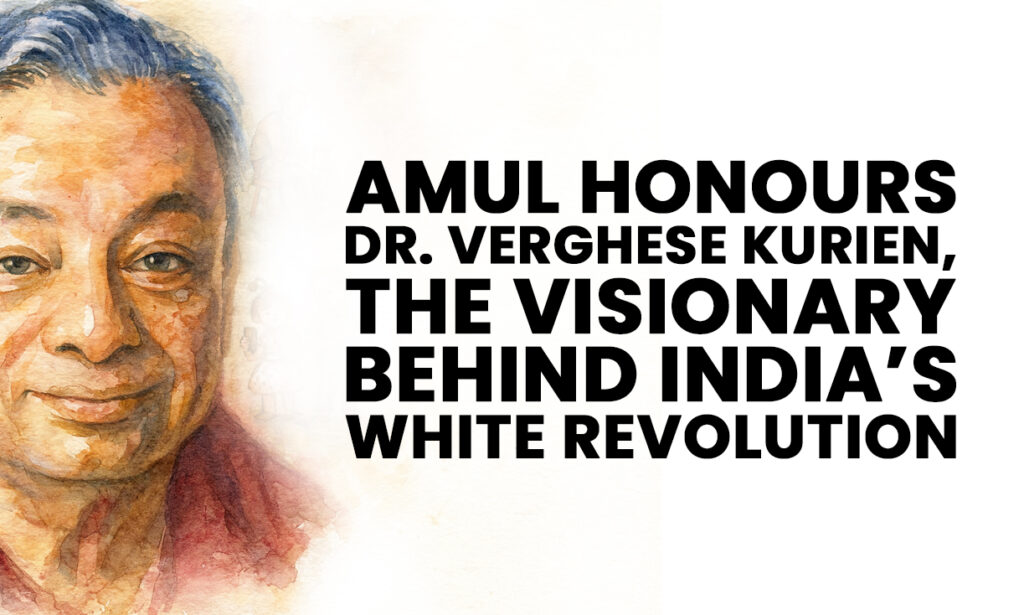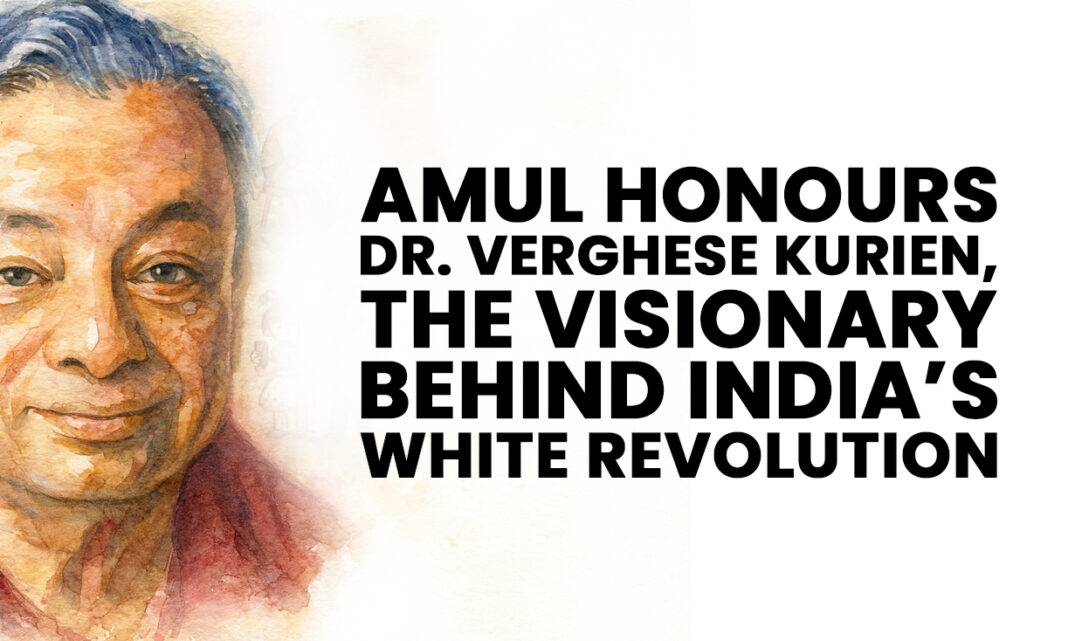On Dr. Verghese Kurien’s 104th birth anniversary, Amul pays tribute to the Milkman of India, whose cooperative model transformed rural livelihoods and made India the world’s largest milk producer. Celebrating his vision and enduring legacy, the tribute reflects how his White Revolution continues to empower farmers and inspire the nation.

Amul India’s tribute to Dr. Verghese Kurien on his 104th birth anniversary is more than a remembrance—it is a reminder of how one man transformed a nation by seeing extraordinary possibility in something as ordinary as a glass of milk. In a country struggling with food shortages, limited resources, and deep rural inequities, Kurien imagined a movement that would not only change the dairy industry but also redefine India’s economic and social landscape. His legacy, deeply intertwined with the rise of Amul, remains one of the most powerful examples of how visionary leadership can unleash collective strength and dignity for millions.
To understand the depth of Kurien’s impact, one must return to the early post-Independence years. India in the 1950s was far from the global dairy powerhouse it is today. Milk production was low, supply chains were fragmented, and exploitation by middlemen was rampant. Rural dairy farmers, despite their hard work, rarely received fair compensation. The country depended heavily on imports and donations of milk powder, exposing a fragile and unequal system. Amid this landscape, Dr. Kurien—a young engineer from Kerala who arrived reluctantly in the small town of Anand, Gujarat—saw both a challenge and an opportunity. What he would go on to build from that remote cooperative would become the largest dairy development program in the world.
Kurien’s partnership with Tribhuvandas Patel, founder of the Kaira District Cooperative Milk Producers’ Union, was the beginning of a revolution. Together, they envisioned a system where farmers were the owners, controllers, and beneficiaries of the dairy value chain. The idea was deceptively simple but profoundly transformative: eliminate middlemen, empower producers, ensure fair prices, and build infrastructure that served the farmer first. Amul became the living model of this philosophy—a cooperative that prioritised transparency, trust, and collective progress.
What set Kurien apart was not merely his technical expertise but his insistence on dignity and agency for rural producers. He believed that development could not be imposed from above; it had to be built with people, by people, and for people. The cooperative structure he championed ensured that decisions flowed from the farmers upward—not the other way around. For the first time, millions of rural households, including women who managed cattle at home, found themselves at the center of a national economic transformation. Their small contributions became part of a massive, organised, and efficient network that reshaped India’s dairy landscape.
Kurien’s genius was also in recognizing the power of technology and scale. Under his leadership, India embraced modern dairy processing, advanced testing, storage innovations, and transportation networks that enabled farmers in remote villages to supply quality milk efficiently. The success of the Anand model led to Operation Flood, the world’s largest dairy development program, which replicated the Amul structure across states, linking rural farmers to urban consumers through a vast, reliable, and farmer-owned system. Operation Flood was not merely about increasing milk supply—it was about building a nationwide movement rooted in empowerment.
By the 1990s, the results were astonishing. India had overtaken countries like the United States to become the world’s largest milk producer, a position it still holds today. What had once been a nation dependent on milk imports had become self-sufficient, even surplus-producing. This transformation was not an accident or a miracle; it was the outcome of Kurien’s relentless pursuit of equity, efficiency, and innovation. His ability to unite people around a shared vision made the White Revolution one of the most successful development stories globally.
Amul’s famous advertising campaigns, especially the iconic Amul girl, further cemented Kurien’s vision of connecting everyday moments with the power of milk. He understood that marketing was as essential as production. By weaving humour, cultural relevance, and social commentary into the brand’s identity, he made Amul not just a dairy company but a cultural symbol. The brand became synonymous with trust, quality, and pride in Indian innovation.
Even after decades, Dr. Kurien’s philosophy continues to guide Amul’s operations. The cooperative model that he refined remains the backbone of India’s dairy sector, supporting millions of farmers across states like Gujarat, Rajasthan, Karnataka, Maharashtra, and Punjab. Many of these farmers still rely on dairy as their most dependable source of income. For countless rural women, dairy work provides financial stability and autonomy, making the White Revolution a catalyst for gender empowerment as well.
On his 104th birth anniversary, Amul’s tribute carries emotional resonance because Kurien’s principles remain deeply relevant. In today’s India, where conversations around sustainable agriculture, rural entrepreneurship, and cooperative development are resurfacing, Kurien’s model offers a guiding framework. His belief that farmers deserve ownership—not charity—and that economic freedom begins with structural empowerment continues to inspire policymakers, entrepreneurs, and development leaders.
Kurien’s story also serves as a counter-narrative to the idea that development must come from external intervention or corporate expansion. His career showed that India’s most meaningful revolutions have often emerged from within—from grassroots leadership, local collaboration, and collective determination. The Amul cooperative stands as living proof that when the smallest producers unite with shared purpose, they can build institutions of national significance.
What makes Kurien’s legacy particularly enduring is the emotional connection people feel to his work. Milk is more than a product in India; it is tied to childhood, nourishment, hospitality, festivals, and everyday comfort. That a man could take this humble, universal element of life and build an economic model that empowered millions gives his story mythic resonance. He saw farmers not as beneficiaries but as partners. He saw milk not as a commodity but as a catalyst for change.
Today, India’s dairy sector faces new challenges—climate change, rising costs, shifting consumer preferences, and competition from plant-based alternatives. Yet Kurien’s framework still offers direction: innovate, cooperate, and remain rooted in the needs of producers. Even as new technologies emerge, the foundational values he set—fairness, transparency, and farmer-first systems—remain the industry’s compass.
Amul’s tribute on his 104th birth anniversary is more than a ceremonial gesture; it is a reaffirmation of identity. It acknowledges that the company’s success, India’s status as the world’s largest milk producer, and the livelihoods of millions all trace back to one man’s refusal to accept that rural India must remain synonymous with poverty and powerlessness. Kurien believed that the future of the nation could be reshaped by giving its farmers the tools, trust, and freedom to succeed.
As India looks ahead, Dr. Verghese Kurien’s life continues to serve as a blueprint for inclusive progress. His White Revolution was not just about milk—it was about dignity, resilience, and the transformative power of collective effort. On this anniversary, Amul’s tribute reminds the nation that some revolutions begin with a simple idea, a shared purpose, and the courage to imagine a better world.







